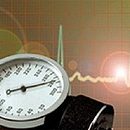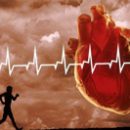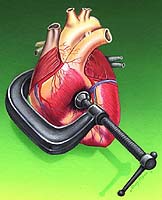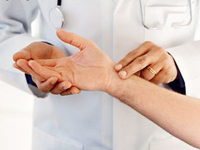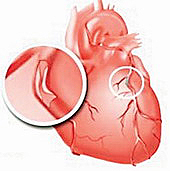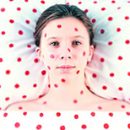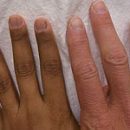What is hiding behind the term «pericarditis»? What are the features of the course of this disease in children? How to recognize this ailment? How to help a child suffering from pericarditis? The author of this article knows the answers to these questions.
Content
Describe pericarditis can be schematically. The heart has an outer shell (pericardium). This is a kind of heartbag in which the heart beats. It consists of two sheets. The outer sheet is more dense, internal - from one layer of cells.
This «a bag» fixes the heart in the chest and keeps the heart in a normal position. It serves as a barrier to penetrate the infection from the chest in the heart, prevents the excessive expansion of the heart, helps maintain the desired pressure in the heart chambers.
In the norm pericardium contains a certain amount of transparent serous fluid (5-30 ml.). If an additional fluid accumulates in the pericardia cavity, it can lead to an increase in pressure in the pericardia cavity and to violate normal heart. Such a pathological condition is called a sharp tamponade heart. If the fluid accumulates gradually, then the acute tamponade of the heart does not develop, but in this case other pathological processes arise (blood stagnation in hollow veins and in the system of liver and portal veins).
Pericarditis can be dry and discharge.
Pericardits diagnose approximately 1% of children.
A sharp dry pericarditis usually begins with fever, tachycardia and almost constant pain syndrome. In early age children, painful syndrome is manifested by periodically emerging concern, cry. Pains are more often localized in the navel area.
Older children complain about pain in the chest, behind the sternum, amplifying with deep breathing and change of the position of the body, giving up to the left shoulder.
Acute payout pericarditis causes a sharp deterioration in the state of the child. Dyspnea appear, blunt pain in the heart, the child takes a forced half-sideways with a head tilt forward.
Some children have probing voice, cough, idol, nausea, vomiting, stomach pain. Blood pressure decreases (approximately 10-20 mm RT.Art.), a paradoxical pulse appears (reducing the filling of the pulse on the breath). Increases and becomes a painful liver, extracts are possible.
Develops heart cavity syndrome. In infants, this syndrome has nonspecific manifestations. Increased pressure in the upper hollow vein causes an increase in intracranial pressure, which is accompanied by meningism (vomiting, blowing a large spring, the rigidity of the occipital muscles). Become well visible and palpable veins brushes, cervical and elbow veins, usually invisible at this age.
Increasing the volume of fluid in the pericardial cavity can cause a tamponade of the heart. At the same time, the condition of the child sharply deteriorates, it becomes very restless, fear fears, shortness of breath, acricyanosis and cold sweat appear. In the absence of emergency care, a sudden death is possible.
Chronic pericarditis can be exudative (usually tuberculosis etiology), adhesive (constrictive) and mixed; with squeezing the cavities of the heart or without it.
In case of chronic exudative, the pericardia of children worries increased fatigue, shortness of breath, unpleasant sensations in the field of the heart, especially with excessive physical exertion.
Adhesive pericarditis without a compression of the heart proceeds asymptomatic. Constrictive pericarditis manifests itself with general weakness, sense of gravity in the right hypochondrium. In case of inspection, the poverty of the face, swelling and pulsation of the cervical veins, cyanosis, increasing in a horizontal position, ascites. Foot edema rarely arise.
With acute exuudative pericardia, a tamponade of the heart is possible, in the constrictive - insufficiency of blood circulation.
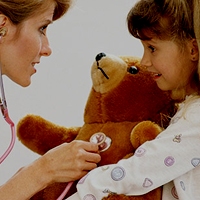 With acute pericardia, bedding is needed for the entire activity of the process. When chronic pericade mode depends on the state of the patient. Limit physical activity. The diet should be full, food should be taken fractionally, small portions. Limit the consumption of cook salt.
With acute pericardia, bedding is needed for the entire activity of the process. When chronic pericade mode depends on the state of the patient. Limit physical activity. The diet should be full, food should be taken fractionally, small portions. Limit the consumption of cook salt.
Treatment with sharp dry or with a little distance pericarditis predominantly symptomatic (anti-inflammatory drugs, analgesics with pronounced pain syndrome, means of improving metabolic processes in myocardium, potassium preparations, vitamins).
When paying pericardia with a rapidly increasing or recurrent accumulation of the liquid, it may be necessary in an urgent puncture (paracentsis) pericardium. With purulent pericardia sometimes it is necessary to drain the pericardia cavity and enter antibiotics into it.
With a silicate pericardia with compulsion of the heart cavities, operational intervention is necessary (pericardotomy with maximum removal of adhesions and cutting and changed pericardial leaflets).
Treatment in secondary pericardits enters the program of therapy of the main disease.
Prevention is possible only secondary: dispensary monitoring in the cardiorevmatology office, regular electrocardiogram, elimination of chronic infection, recovery, dosage physical activity.
In most cases of acute pericarditis, the forecast is favorable. With a secondary pericardius, it depends on the course of the main disease. The outcome of any pericarditis variant may be a transition to a chronic flow, formation «Panciro» Hearts (constrictive, adhesive, adhesive pericarditis). Danger to life represents a sharply developed tamponade of the heart. Chronic pericarditis, especially with the compression of the cavities of the heart, can lead to a disablement of a child.

